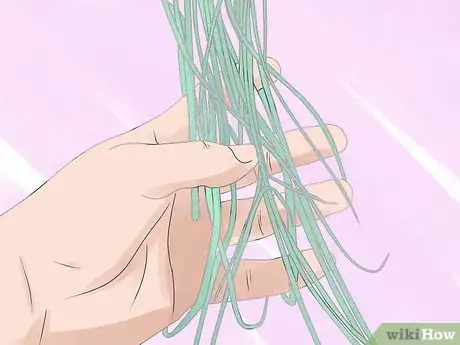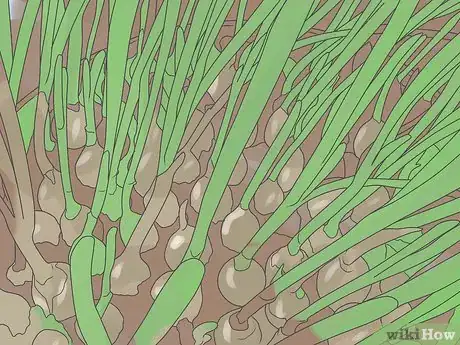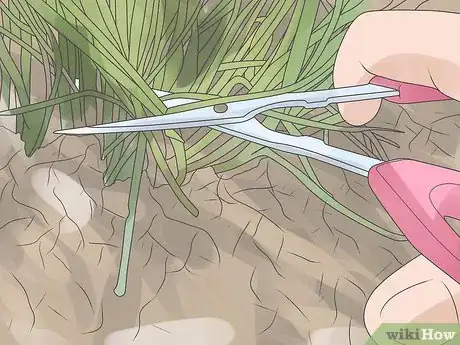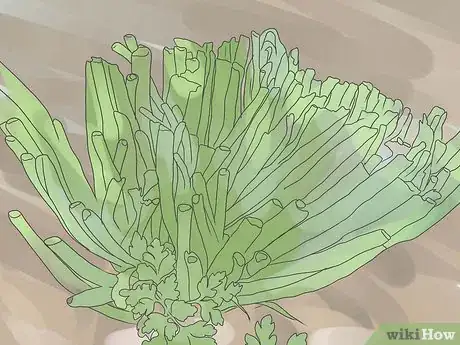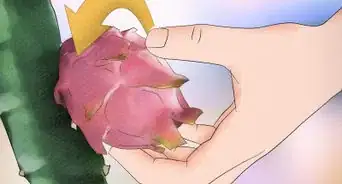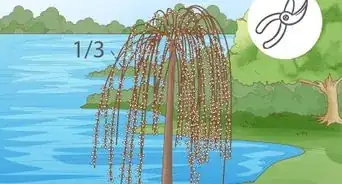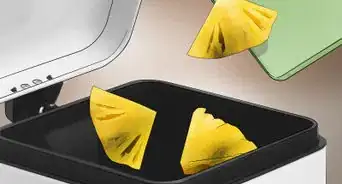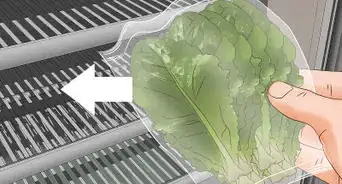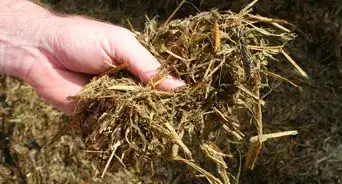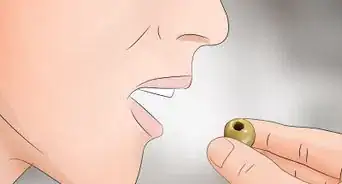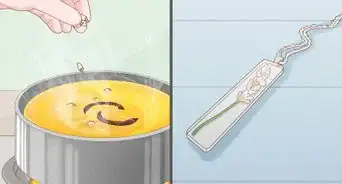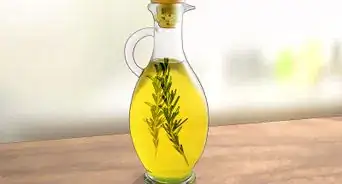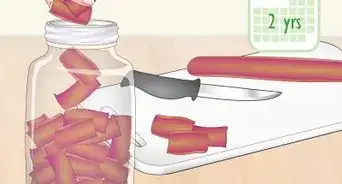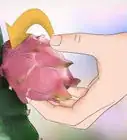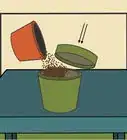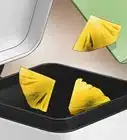This article was co-authored by Andrew Carberry, MPH. Andrew Carberry is a Food Systems Expert and the Senior Program Associate at the Wallace Centere at Winrock International in Little Rock, Arkansas. He has worked in food systems since 2008 and has experience working on farm-to-school projects, food safety programs, and working with local and state coalitions in Arkansas. He is a graduate of the College of William and Mary and holds a Masters degree in public health and nutrition from the University of Tennessee.
wikiHow marks an article as reader-approved once it receives enough positive feedback. In this case, 92% of readers who voted found the article helpful, earning it our reader-approved status.
This article has been viewed 213,255 times.
Chives (Allium schoenoprasum) are the sort of herbs that have endless possibilities. They can be used in salads, soups, meat dishes, in cheeses...the list is truly infinite. Growing your own chives is a great idea, but it is also important to know when and how to harvest them. Scroll down to Step 1 to being learning about harvesting chives.
Steps
Knowing When and What to Harvest
-
1Select the right part of the plant. Look for the long, green, hollow leaves. These are round in shape. These are the parts of the plant that you want to use in your recipes.[1]
- The chive flowers are also edible but do not have the same flavor as a chive stalk. They are best used as a garnish in a salad or soup.
-
2Know when to begin harvesting chives. You can begin harvesting the chives when the leaves grow large enough to be clipped and used.Advertisement
-
3Have several plants growing at once. This will help when it comes to harvesting. If you only have one plant, you might over harvest it by cutting the leaves before they have had enough time to grow. If you have multiple chive plants, you can harvest the leaves of one and then wait for those leaves to grow back while you harvest the leaves from another plant.[2]
Harvesting the Chives
-
1Gather the leaves into a bunch. Use a pair of sharp, clean scissors to remove the leaves. Do not cut too closely to the bulb, or you will spoil the chances of the chives regrowing. You want to leave about ½ an inch of green leaves attached to the bulb, above the soil.[3]
- If you just need a few chives, harvest from the outside of the clump. Sharp scissors work best as they will not rip the plant like dull scissors will. Leave the rest to grow.
- If you want to continue to harvest them in winter, transfer a clump of chives to a pot. Place it on a sunny windowsill. You can then have fresh chives throughout the winter.
-
2Use your chives or store them. If storing, cut chives can be kept in the refrigerator inside a sealed plastic bag for up to one week. It is also possible to freeze them in ice cubes or to freeze dry them.
- Before using your chives, rinse them off under cool, running water to remove any dirt or debris from the garden.[4]
- Another good method for preservation is to make chive vinegar.
-
3Use chives in a recipe. You can use chives in a salad. They also make a great baked potato topping. The possibilities for chives are truly endless![5]
Expert Q&A
Did you know you can get expert answers for this article?
Unlock expert answers by supporting wikiHow
-
QuestionWhen do I harvest chives?
 Andrew Carberry, MPHAndrew Carberry is a Food Systems Expert and the Senior Program Associate at the Wallace Centere at Winrock International in Little Rock, Arkansas. He has worked in food systems since 2008 and has experience working on farm-to-school projects, food safety programs, and working with local and state coalitions in Arkansas. He is a graduate of the College of William and Mary and holds a Masters degree in public health and nutrition from the University of Tennessee.
Andrew Carberry, MPHAndrew Carberry is a Food Systems Expert and the Senior Program Associate at the Wallace Centere at Winrock International in Little Rock, Arkansas. He has worked in food systems since 2008 and has experience working on farm-to-school projects, food safety programs, and working with local and state coalitions in Arkansas. He is a graduate of the College of William and Mary and holds a Masters degree in public health and nutrition from the University of Tennessee.
Food Systems Expert
-
QuestionHow do I cut roots from clipped chives?
 Andrew Carberry, MPHAndrew Carberry is a Food Systems Expert and the Senior Program Associate at the Wallace Centere at Winrock International in Little Rock, Arkansas. He has worked in food systems since 2008 and has experience working on farm-to-school projects, food safety programs, and working with local and state coalitions in Arkansas. He is a graduate of the College of William and Mary and holds a Masters degree in public health and nutrition from the University of Tennessee.
Andrew Carberry, MPHAndrew Carberry is a Food Systems Expert and the Senior Program Associate at the Wallace Centere at Winrock International in Little Rock, Arkansas. He has worked in food systems since 2008 and has experience working on farm-to-school projects, food safety programs, and working with local and state coalitions in Arkansas. He is a graduate of the College of William and Mary and holds a Masters degree in public health and nutrition from the University of Tennessee.
Food Systems Expert
-
QuestionIs the flower on top what I dry and plant next year?
 Community AnswerYes. The flower will dry and open to release many small seeds. Seeding is very easy, as these things germinate very quickly.
Community AnswerYes. The flower will dry and open to release many small seeds. Seeding is very easy, as these things germinate very quickly.
Things You'll Need
- Chive plants (several)
- Clean, sharp scissors
References
- ↑ http://www.almanac.com/plant/chives
- ↑ https://www.growveg.com/guides/how-to-harvest-chives-all-year-round/
- ↑ http://www.almanac.com/plant/chives
- ↑ http://dish.allrecipes.com/cleaning-and-preparing-herbs/
- ↑ https://www.bonappetit.com/test-kitchen/cooking-tips/article/the-best-way-to-use-chives-from-soups-to-vegetables-to-main-dishes
- ↑ https://www.youtube.com/watch?v=1vxi6fc9GRM
- https://www.thekitchn.com/the-best-ways-to-preserve-chives-220338
About This Article
To harvest chives, gather a bunch of the green, hollow leaves on your plant and chop them off with a pair of scissors. You'll want to make sure you leave about an inch of green leaves above the bulb, which will allow the chives to grow back. Next, put the cut chives into a plastic bag and store them in the refrigerator for a week. Alternatively, you can freeze them inside ice cubes to store them longer. If you want to use the chives right away, rinse them in water before adding them to a salad or baked potato topping. For tips on how to know when chives can be harvested, read on!
